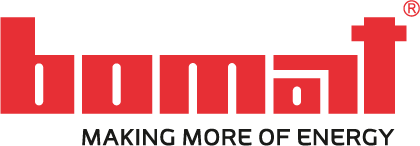FAQ
Frequently asked questions about BOMAT condensing technology
In this chapter you can find answers to the most frequently asked questions. Please choose the topic by clicking on the mouse.
Condensing technology
Whenever you save energy, you also save on fuel costs. The ratio of capital expenditure to fuel cost savings becomes ever more favourable, the higher the system’s specific energy consumption.
It is generally the case that whenever flue gases are discharged into the environment unused, the latent heat contained in these gases can be harnessed. Ceramic heat exchangers enable the heat to be utilised, even if the flue gases are corrosive.
BOMAT heating systems based on condensing technology allow the recovery of around 10-15 % of additional energy compared with conventional low temperature heating systems – depending on the fuel used (oil/gas) – and continue to save energy year on year. Actual fuel savings are even greater when compared with older boiler systems.
In industrial waste heat recovery, the savings that can be achieved with BOMAT heat exchangers are greater still.
BOMAT dual circuit technology can also be used in older buildings that are often not suited to “conventional” condensing technology. Dual circuit technology allows us to supply sufficiently cold coolant only to the flue and exhaust gas heat exchanger. The boiler circuit can continue to be operated at a higher temperature.
The waste gas, which develops while burning fuel or gas (120°–220° C) is not diverted directly into the chimney but is lead through the corrosion-proof, metal-free heat exchanger thus the temperature of the waste gas will be reduced to 30° –70°C depending on the system and the boiler charge. The waste gas is condensing on the cooler parts of the heat exchanger surfaces – the additionally gained condensation heat is used to warm up the heating water, for the tap water or for the utilization of process heating. Furthermore the loss of waste gas is reduced and will bring simultaneously an energy gain.
- Saving energy through recovery of hot waste gas (flue gas heat and condensation heat).
- Rise in pyrotechnical efficiency.
- The waste gas temperature is only 30°–70° C (depending on the boiler weight and the system). Therefore it is possible to use competitive plastiv waste gas pipes (future orientated corrosion-proof chimney refurbishment).
- BOMAT can also be integrated in to existing heating plants.
- g. A higher ecological utility, a lifetime contribution to protect the environment with a positive long-term impact.
During the combustion of 1 litre fuel up to 0.8 litre condensate or 1 m³ gas up to 1.4 litre condensate can be emerged (pH-value approx. 2). The condensate is acid both with fuel or gas (pH-value 7 = neutral) and represents a combustion acid which includes a series of environmental pollutants. These aggressive combustion acids damage metallic heat exchangers – as a result unhealthy heavy metals develop and will be washed out together with the condensate directly into the waste water.
Metal-free heat exchangers do not develop heavy metals. Also the acid emission through the chimney can be reduced by up to 80%!
You can recognize it
- according to the waste gas recovery plant (AWR) with metal-free heat exchanger
- according to the high condensation performance (0.8 litre condensate per litre fuel and 1.4 litre per m3 natural gas)
Chimney refurbishement
During the decision process for a heating system the chimney should be considered. If you do not, substantial follow-up costs could occur.
The BOMAT condensing technology ensures, that the waste gas temperature is not higher than 120°C. Therefore competitive, long-term corrosion-proof plastic pipes can be used. Normally the waste gas temperature is between 30° and 70°C.
Environment
BOMAT energy technology contains a neutralisation and a processing system, which neutralizes the combustion acids. For this reason the condensate can be led unscrupulously into waste water.
The waste gas emission (CO, CO2, S02, NOX, CnHm, etc.) can be reduced drastically with the BOMAT-condensing technology.
The significance of the resulting reduction in pollution becomes clear when you look at the amounts of pollutants and their effects on our environment. The combustion of 1 litre of fuel oil or 1 m3 of gas can generate between 1 and 1.6 litres of combustion acid. Usually, this enters our environment via the chimney as flue and exhaust gas and pollutes the Earth’s atmosphere, affecting the climate and damaging the natural world by falling as acid rain. For example, 1 litre of condensate is sufficient to pollute 70,000 litres of fresh water to such an extent that fish cannot survive in it any more.
The reduction in flue and exhaust gas temperatures and the resulting energy savings also positively help to counteract global warming.
BOMAT heating technology therefore makes an important contribution to protecting the Earth’s atmosphere.
The Enquete-Commission of the German Bundestag “protection of the earth’s atmosphere” has requested the condensing-technology for heating systems as a requirement of each citizen to save energy, maintain resources and guarantee a reduction of contaminants.

